We woke up early to explore Cairo city -as well as visit to several of the religious sites, a souk, and the Egyptian Museum. Cairo is occasionally called "the city of a thousand minarets", because everywhere you are it seems a mosque is not far away. One thing I appreciate anywhere I travel is the attention and detail that was once paid to places of worship. The intricate patterns and textures are inviting and beg to be looked at more closely.
Cairo is occasionally called "the city of a thousand minarets", because everywhere you are it seems a mosque is not far away. One thing I appreciate anywhere I travel is the attention and detail that was once paid to places of worship. The intricate patterns and textures are inviting and beg to be looked at more closely. 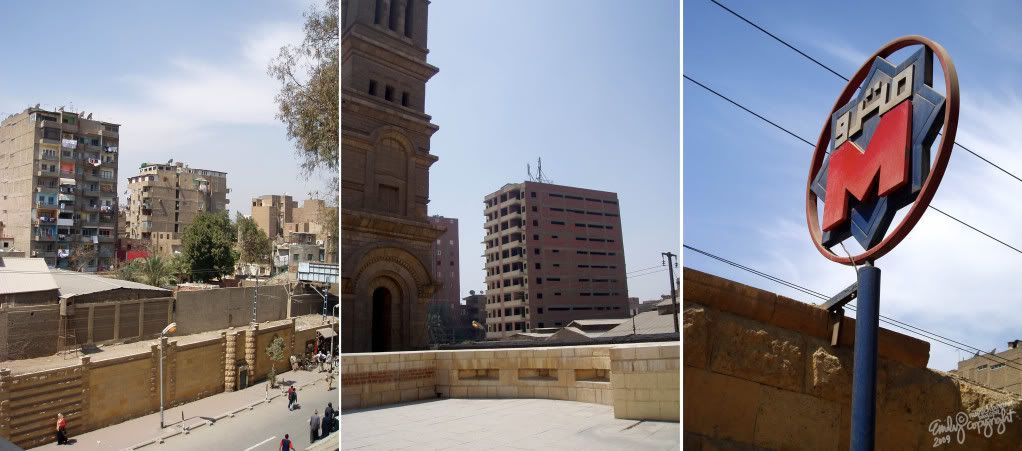 Another interesting feature is that buildings that are unfinished are not subject to the same tax laws, therefore many of the buildings appear to be continually having something done.
Another interesting feature is that buildings that are unfinished are not subject to the same tax laws, therefore many of the buildings appear to be continually having something done.  Our first stop was The Citadel, which sits perched on a large hill overlooking the city. Typically the highest hills or view points in any city end up also being the center for government, which was also housed here for sometime.
Our first stop was The Citadel, which sits perched on a large hill overlooking the city. Typically the highest hills or view points in any city end up also being the center for government, which was also housed here for sometime. 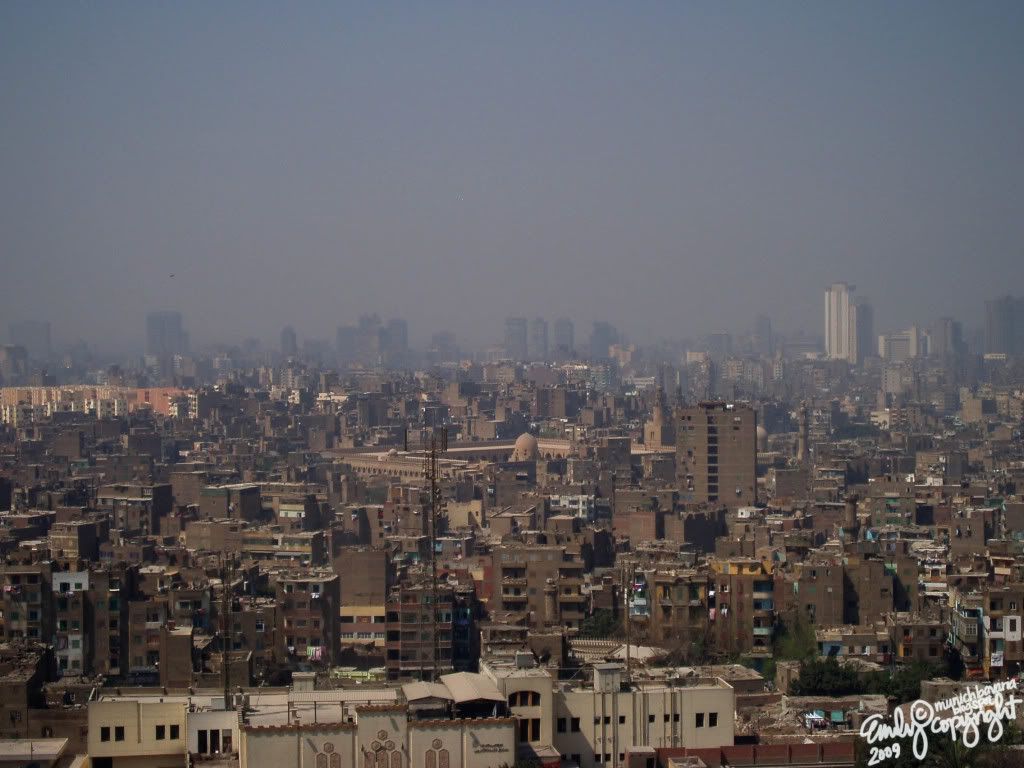 The main features of the Citadel are the The Alabaster Mosque at the Citadel of Salah el-Din and the striking view over the city and into Giza. The mosque was supposedly built here due to the air quality. Salah el-Din is said to have hung meat around the city at various places and it took longest to spoil in this location. Judging from the smog below I would have to believe the air quality throughout the city has not improved.
The main features of the Citadel are the The Alabaster Mosque at the Citadel of Salah el-Din and the striking view over the city and into Giza. The mosque was supposedly built here due to the air quality. Salah el-Din is said to have hung meat around the city at various places and it took longest to spoil in this location. Judging from the smog below I would have to believe the air quality throughout the city has not improved.
I quickly understood why the smog is wrecking havoc on the ancient monuments as well as people's health, but thankfully we were distracted by the sights to concentrate too much on the air quality. The Alabaster Mosque is truly beautiful. While we were there the dome was being restored with silver leafing. The Ottoman style architecture is also unique. The other mosques in the city do not have the same appearance. To enter the mosque you are required to take your shoes off, or get shoe coverings, and as a woman to put a head scarf on out of respect. I enjoyed feeling the cold stone under my feet as I tried to better understand this fascinating faith and beautiful architecture.
The Alabaster Mosque is truly beautiful. While we were there the dome was being restored with silver leafing. The Ottoman style architecture is also unique. The other mosques in the city do not have the same appearance. To enter the mosque you are required to take your shoes off, or get shoe coverings, and as a woman to put a head scarf on out of respect. I enjoyed feeling the cold stone under my feet as I tried to better understand this fascinating faith and beautiful architecture.  It was nice to be invited into a sacred place and to have Rani answer our questions about his faith and religion. We took a seat on the bright colored carpets as he explained the details of the prayer room to us. Islamic churches do not have icons, therefore you will not see images of prophets or people decorating the sacred space.
It was nice to be invited into a sacred place and to have Rani answer our questions about his faith and religion. We took a seat on the bright colored carpets as he explained the details of the prayer room to us. Islamic churches do not have icons, therefore you will not see images of prophets or people decorating the sacred space. 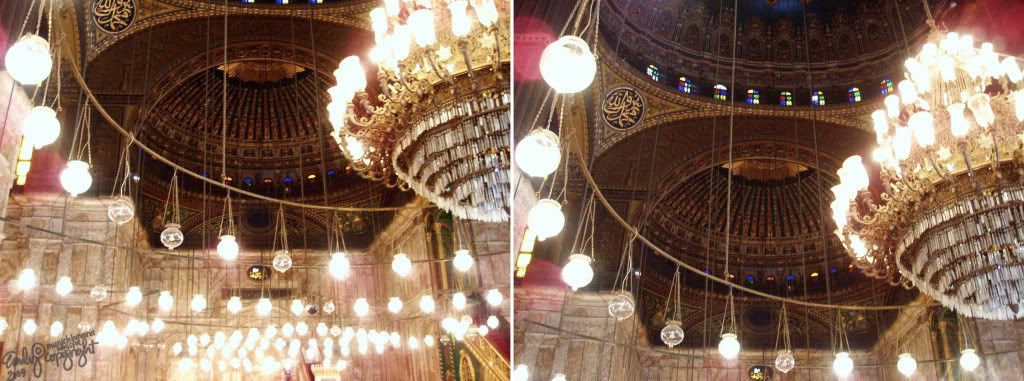 The call to prayer (Adhān) is really pretty special. In ancient times a man with a resonating voice would be 'the caller' and announce to everyone that it was prayer time. Different areas of the middle east follow different calls and the same thing is not always said in each country or each denomination (Sunni and Shia). In Egypt, Sunni is the most practiced form of Islam.
The call to prayer (Adhān) is really pretty special. In ancient times a man with a resonating voice would be 'the caller' and announce to everyone that it was prayer time. Different areas of the middle east follow different calls and the same thing is not always said in each country or each denomination (Sunni and Shia). In Egypt, Sunni is the most practiced form of Islam.
Before going to prayer a cleansing ritual is required and it follows a particular order moving from right to left and is done three times. It consists of washing the hands, mouth, nose, face, arms, forehead and hair, ears and finally the feet. 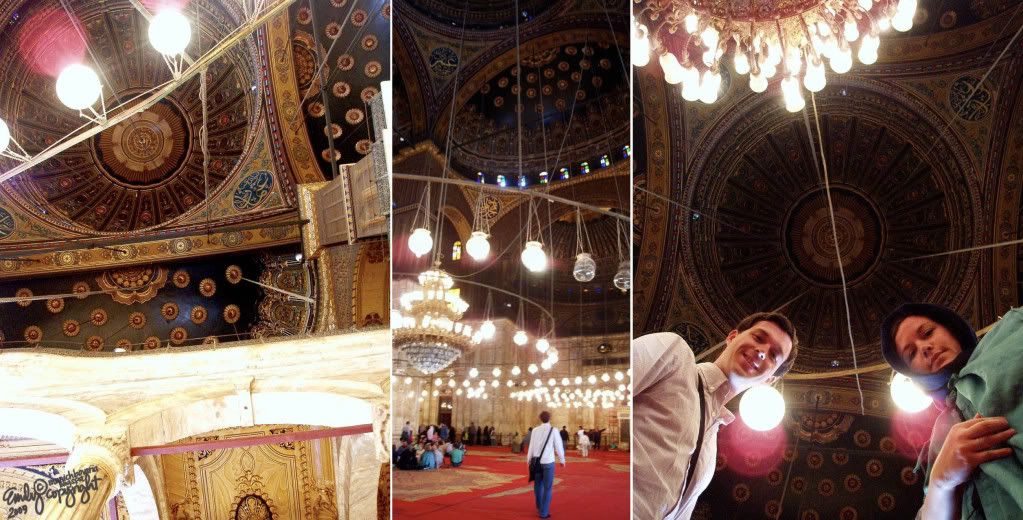 Just like other religions, some people are more devout than others, however answering the call to prayer at the proper times is supposed to gain favor in God's eyes. If someone misses prayer time they can pray on their own. Driving down the heavily congested roads I noticed a Qur'an in nearly everyone's window.
Just like other religions, some people are more devout than others, however answering the call to prayer at the proper times is supposed to gain favor in God's eyes. If someone misses prayer time they can pray on their own. Driving down the heavily congested roads I noticed a Qur'an in nearly everyone's window.
The 5 pillars of Islam include:
Shahadah - declaration of one God. This is written inside the mosque and also part of the call to prayer.
Salah - ritual prayer. This is required 5 times a day (dawn, noon, afternoon, sunset, nightfall)
Zakat - alms giving from the rich to the poor
Sawm - fasting during Ramadan
Hajj - pilgrimage to Mecca
During Ramadan and fasting Rani explained there would be tables of food lining the streets and this was part of giving alms. I asked if he had been able to make his hajj (pilgrimage to Mecca), which costs between $5,000 and $10,000, but he's still working towards that.  Prayer is always directed towards Mecca. I'm not really certain how they always know which direction Mecca is, however I did once see a man open a muṣalla prayer mat in Marienplatz and begin praying here in Munich.
Prayer is always directed towards Mecca. I'm not really certain how they always know which direction Mecca is, however I did once see a man open a muṣalla prayer mat in Marienplatz and begin praying here in Munich.
As we talked with Rani about his new marriage and his life, we quickly understood things more clearly. Some things are still strange to me, coming from a Western culture (such as being able to marry 4 women), while other things I already knew (Jesus was viewed as a prophet, however they view the Holy Trinity to be polytheism). 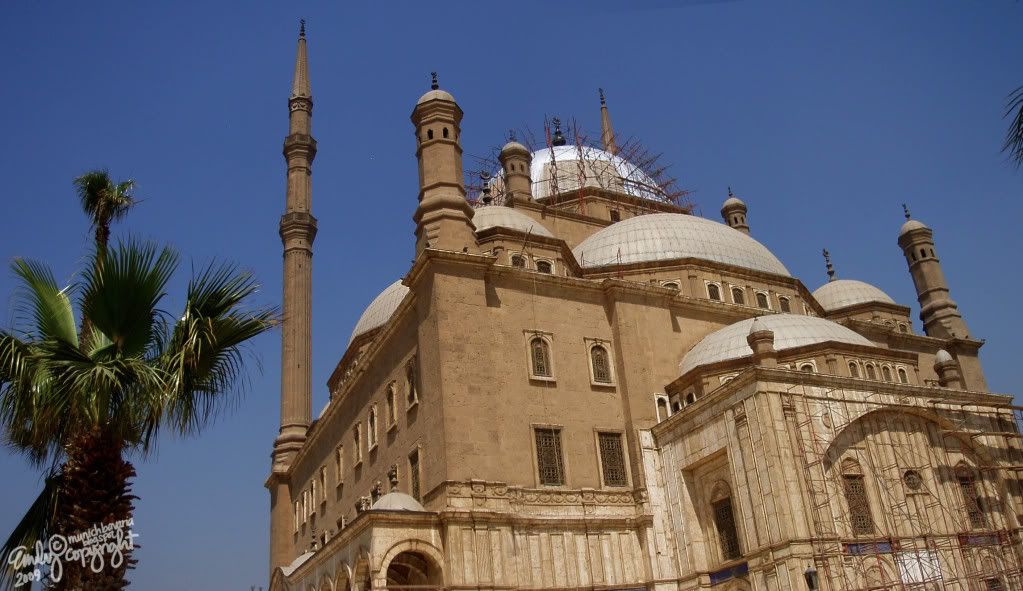 We also discussed divorce, which is very common in Egypt. He told us he went broke from getting married. He was required to provide (and he continually stressed this) proper furnishings - including curtains, carpets, and furniture. If he were to take another wife his current wife would have to agree to it. If the woman had previously been divorced he would not have to offer as much. He said this was not as common as it once was, I assume due to the rising economic costs. His father had a second wife (which he called his step-mother) and for some time they lived in the same house, however they later had two separate households.
We also discussed divorce, which is very common in Egypt. He told us he went broke from getting married. He was required to provide (and he continually stressed this) proper furnishings - including curtains, carpets, and furniture. If he were to take another wife his current wife would have to agree to it. If the woman had previously been divorced he would not have to offer as much. He said this was not as common as it once was, I assume due to the rising economic costs. His father had a second wife (which he called his step-mother) and for some time they lived in the same house, however they later had two separate households.
Women are also able to divorce men, however in doing so she renounces any say on their belongings. Lower and Upper Egypt differ as well. In Upper Egypt it sounds as though it's not as traditional and women would be able to help pay for a wedding, while in Lower Egypt that was considered shameful for a man.
Stefan asked about the veiling of women and whether the woman in full burkas were more devout. Rani told us it depends on her upbringing and what is agreed upon by her husband. He suggested that some women don't veil at all (most likely the women living in Western areas, such as the US). I recently read that many Islamic women in the middle east are suffering from vitamin D deficiencies due to their hijab and being covered except for hands, feet, and occasionally face.
In contrast, Egyptian men can display their piety by having a 'zebibah' or dark mark on their foreheads from hard pressing into the carpets during prayer. It's worn as a badge of honor and I saw several men with darkened foreheads through our trip.  After leaving the Mosque we drove past the City of the Dead, which intrigues me. We did not stop and Rani stated that the tourist board discourages tourists from visiting, perhaps because they don't like to publicize some 500,000 people that live amongst the graves. I don't think I would have even realized that it was a graveyard because it looked so different from the graveyards that I am familiar with.
After leaving the Mosque we drove past the City of the Dead, which intrigues me. We did not stop and Rani stated that the tourist board discourages tourists from visiting, perhaps because they don't like to publicize some 500,000 people that live amongst the graves. I don't think I would have even realized that it was a graveyard because it looked so different from the graveyards that I am familiar with. 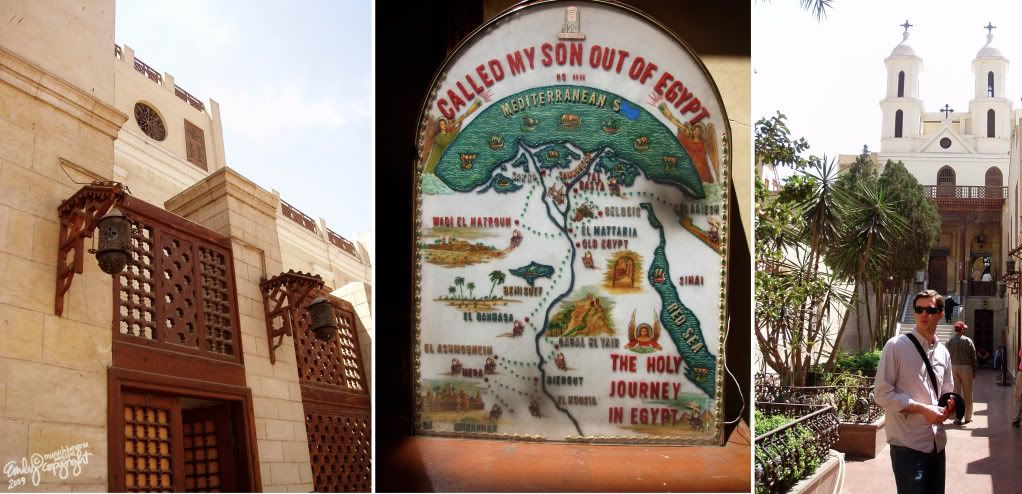 We visited Coptic Cairo, which is the Christian area of town. The tourist police stopped Rani and wanted to see identification, which quickly became common place for him. The area is not very large and the churches are very compact. Stefan and I were impressed with Rani's knowledge about other religions.
We visited Coptic Cairo, which is the Christian area of town. The tourist police stopped Rani and wanted to see identification, which quickly became common place for him. The area is not very large and the churches are very compact. Stefan and I were impressed with Rani's knowledge about other religions.  As we visited The Hanging Church he helped clarify some of the things we saw among the 'Copts' as he called them. We arrived not long after a mass and I had to remind myself that it was Sunday.
As we visited The Hanging Church he helped clarify some of the things we saw among the 'Copts' as he called them. We arrived not long after a mass and I had to remind myself that it was Sunday.  Immediately I noticed the smell of incense. The walls were covered with intricate details and many of the parishioners were walking up and touching or kissing everything in sight, which was odd, but in their eyes it helps gain blessings from various saints. The ceiling of this church was based off Noah's Ark, therefore it looks like an upside down boat.
Immediately I noticed the smell of incense. The walls were covered with intricate details and many of the parishioners were walking up and touching or kissing everything in sight, which was odd, but in their eyes it helps gain blessings from various saints. The ceiling of this church was based off Noah's Ark, therefore it looks like an upside down boat. 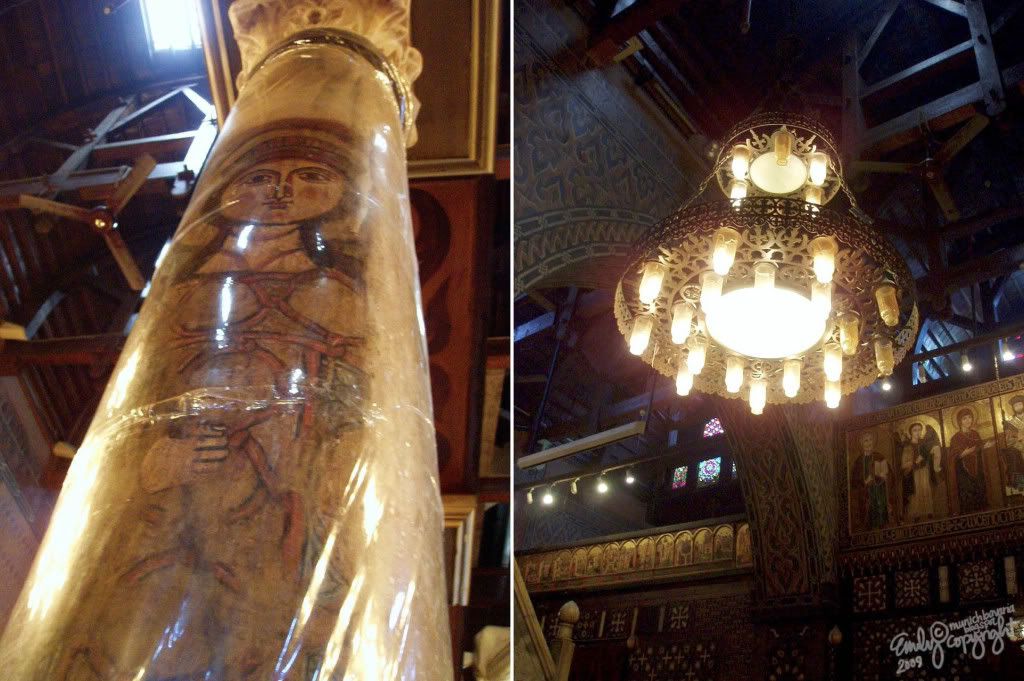 The church is dedicated to the Virgin Mary, who is said to have passed through this area during The Holy Family exodus through Egypt. Supposedly a miracle also occurred and the Virgin's image appeared on a pillar in the church.
The church is dedicated to the Virgin Mary, who is said to have passed through this area during The Holy Family exodus through Egypt. Supposedly a miracle also occurred and the Virgin's image appeared on a pillar in the church.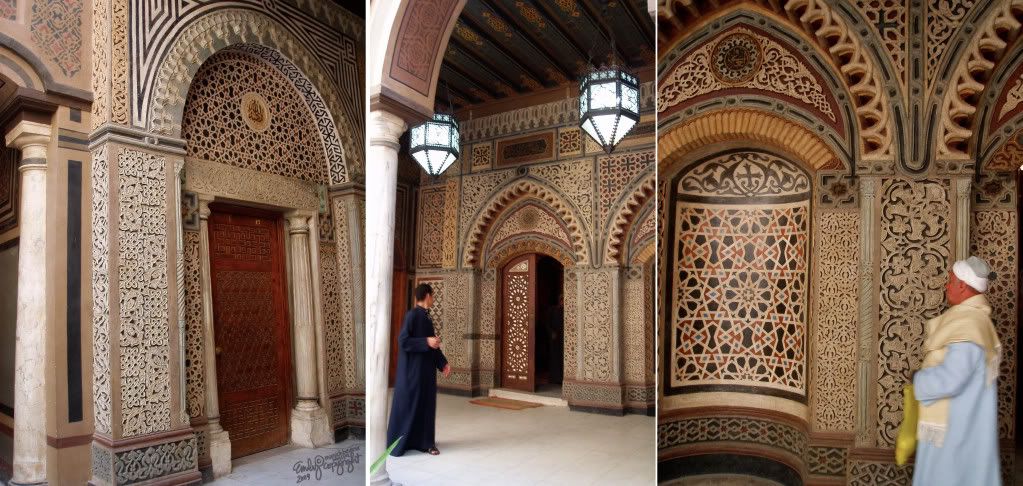 Many of the men had very tanned and beautiful faces with long cotton gowns. They were very striking and their faces seemed to tell so many stories. The entire area exudes so much beauty even through the struggles.
Many of the men had very tanned and beautiful faces with long cotton gowns. They were very striking and their faces seemed to tell so many stories. The entire area exudes so much beauty even through the struggles. The next church we visited was St. George, which is a Greek Orthodox church. Much of the church has been rebuilt, but it is still striking.
The next church we visited was St. George, which is a Greek Orthodox church. Much of the church has been rebuilt, but it is still striking.
After touring around the Coptic area we made our final stop at the Ben Ezra Synagogue, which was tucked away in a very beautiful area. It realy felt like we were walking through history. Rani compared it to old Jerusalem, however we haven't been able to visit yet for a comparison. There are no longer many Jews in Cairo or Egypt in general, so the synagogue remains Jewish property, but it's not fully functioning.  The image in the middle is supposed to be the well that baby Moses was found at. We also went to the crypt where the Holy Family stayed, but it has been extensively damaged due to rising water, which is a major problem in this area. Unfortunately, once again, photos were not allowed.
The image in the middle is supposed to be the well that baby Moses was found at. We also went to the crypt where the Holy Family stayed, but it has been extensively damaged due to rising water, which is a major problem in this area. Unfortunately, once again, photos were not allowed.
I saw so many things at the near by shops - beautiful lanterns, old antique cameras, and subtle tunics and clothing. We saved our quick shopping trip for the Khan el-Khalili, the famed souk of Cairo. 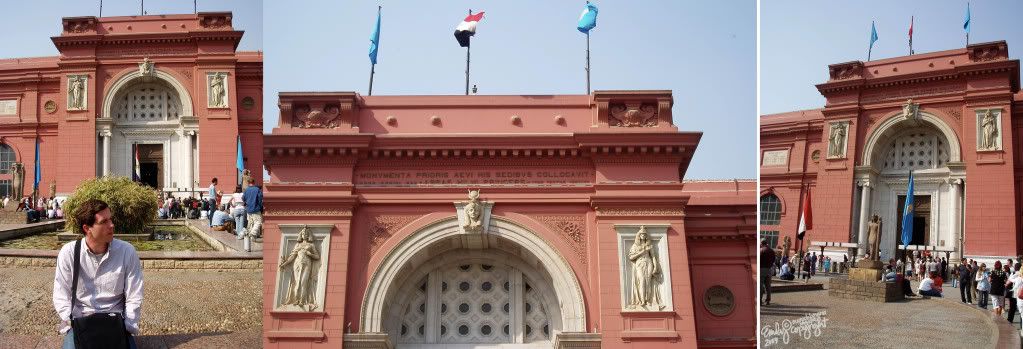 In the Egyptian museum I was surprised to find there is no air conditioner and many of the items had interesting labels that looked as though someone simply typed them on on a typewriter and placed them near the objects. My favorite label was near the replica Rosetta Stone and instead of saying 'The Greeks' it said 'The Geeks'. There are over 165,000 objects in this museum and it's definitely outgrowing it's confines.
In the Egyptian museum I was surprised to find there is no air conditioner and many of the items had interesting labels that looked as though someone simply typed them on on a typewriter and placed them near the objects. My favorite label was near the replica Rosetta Stone and instead of saying 'The Greeks' it said 'The Geeks'. There are over 165,000 objects in this museum and it's definitely outgrowing it's confines.
I had to check my camera, so there are no photos of the interior, but I can safely say it is a very impressive museum with a very extensive and priceless collection. We saw King Tut's death mask and his many tombs.
We also saw the animal mummy room. It seems as anything living could be mummified - from dogs and alligators to fish and birds.
The history is so immense and I continually found myself questioning how much progress people really have made over the last four and a half thousand years.
Tuesday, March 24, 2009
Cairo - القاهرة
Subscribe to:
Post Comments (Atom)
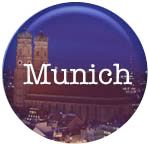
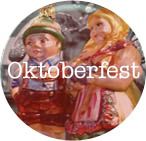



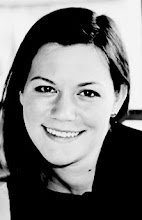


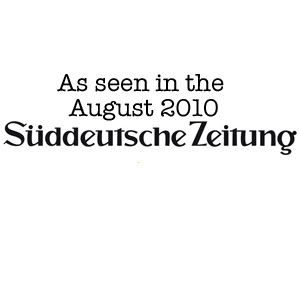
1 comment:
Again, such an intriguing city. It reminds me a lot of Istanbul, with the other faiths existing among the majority faith of Islam. In Istanbul, there is a museum that was once a Greek Orthodox Church, then became a mosque, then a Catholic Church, before becoming the museum. They had to build two pulpits, the original faced Jerusalem, the second facing Mecca. We also learned that every mosque in Istanbul has a slightly different call to prayer. Which may sound more annoying if you understand what they're saying.
The mosques in the Middle East are just breathtaking though.
Looks like you learned a lot from Rani. I'll miss his stories when you're finished recounting the trip :)
Post a Comment